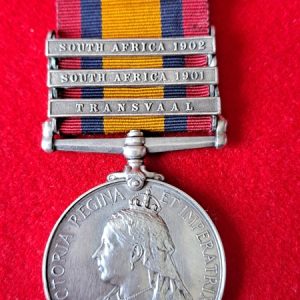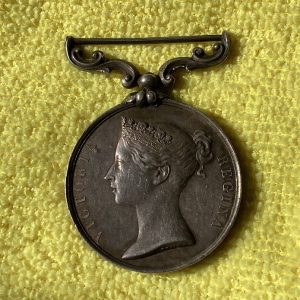Description
Anti-Slavery Gambia 1894 medal.
Medal – East & West Africa Medal clasp Gambia 1894 named to O.C. FLETCHER. A.B. H.M.S. RALEIGH.
Owen Cornelius Fletcher, born to William and Charlotte Fletcher of Bloomsbury, London, 7th April 1871.
Fletcher joined the Royal Navy as Boy 2nd Class 1st July 1887, signing on for 12 years service 7th April 1889. He served on H.M.S. Volage (May to Dec 1889), H.M.S. Monarch (Dec 1889 to May 1890), H.M.S. Wildfire (briefly), H.M.S. Howe (June 1890 to Sept 1891), H.M.S. Raleigh (Oct 1891 to February 1895) then his last ship a return to the crew of H.M.S. Wildfire (April 1895 to April 1896).
He was invalided out 10th April 1896 and died soon thereafter in September 1897.
FIGHT AGAINST SLAVERY, MADINA CREEK, GAMBIA, 1894
In 1894, HMS Raleigh was involved in an incursion against slavery in the Gambia, where the ship’s crew participated in the suppression of the slave trade:
The ambush: On February 23, 1894, the Raleigh’s main column was ambushed at Madini Creek. The column was led by Captain Edward Harpur Gamble of the Raleigh and consisted of 225 bluejackets from the Raleigh, HMS Magpie, and HMS Widgeon.
Medalwise there were 371, with this clasp, issued to H.M.S. Raleigh.
Casualties: Eighteen men were killed, including two officers from the Raleigh: First Lieutenant William Arnold RN and Lieutenant Francis Hervey of the Marines. Forty-six officers and men were wounded, including Gamble.
The ships: The ships were under the command of Rear-Admiral Frederick Bedford.
HMS Raleigh was an iron screw frigate that was launched in 1874. It was named after Sir Walter Raleigh (1552-1618).
Detail of the Action
Three ships (HMS Magpie, Raleigh and Widgeon) of the West Africa Squadron, under the command of Rear-Admiral Frederick Bedford, provided the majority of the men for the incursion. The force was split into two columns, with the aims of destroying a number of stockaded villages and capturing Foday Sillah’s main camp at Birkama, between Bathurst (modern Banjul) and the Cadimanze River. One column, commanded by Captain Edward Harpur Gamble of the Raleigh, consisted of two hundred and twenty-five bluejackets (naval personnel) from the three ships. The other, under the command of Lieutenant-Colonel A. D. Corbet of the Royal Marines, had fifty marines and fifty men of the West Indian Regiment. Both columns carried a small field gun.
Corbet’s group was to have a successful foray, destroying several villages and returning safely the next day. Gamble’s column, however, experienced problems. Initially all went well, and they destroyed two villages, but as they advanced they came under intense fire from enemy hidden in the thick bush. Slowed down by the sniping Gamble realised they were running out of water, and so he ordered a retreat back to one of the destroyed villages, where they spent the night without incident. The next day the force retreated further back to the riverbank, to be collected by the boats, only to find that the water was not yet high enough for the boats to come in. Then Foday Sillah’s men attacked, and Gamble’s men found themselves under fire from three sides, with the river preventing any further retreat, and with no cover available. As the attackers were concealed in the bush the gun was of little use, and the situation worsened when many of the native porters, who were carrying the ammunition, decided, understandably, to run away. By the time the boats could come in to rescue the survivors forty-six officers and men had been wounded (including Gamble), and a further eighteen killed, including First Lieutenant William Arnold of the Raleigh, Lieutenant Francis Hervey of the Raleigh’s Marines, and Sub-Lieutenant Francis Meister of the Magpie.
Afterwards
Two postscripts to the story of the fight at Madina Creek: the bodies of Lieutenants Arnold and Hervey were recovered by the boats which rescued the survivors, but the other bodies, including that of Lieutenant Meister, were taken away by the slavers and never recovered; a few days after the defeat the British went in again, with larger numbers and a spirit of revenge, and drove Foday Sillah out of the region, into French-controlled territory further east, where he was captured and executed. His removal appears to have ended slavery in The Gambia.
Footnotes
Britain abolished slavery domestically in 1807, banned trading in the Empire in 1833, and for the remainder of the century was at the forefront of attempts to stop the slave trade. As its empire expanded it therefore came into direct conflict with established trading interests, and this conflict went on for much longer than one would think.
By the mid-19th Century the Atlantic slave trade had virtually disappeared, but that did not mean slavery had ceased. The market within Africa itself for slaves was still huge, and indeed grew as the plantation culture developed within the continent. Slave trading thus continued to be a very profitable occupation, and the leading Arab traders were very wealthy and powerful men. In The Gambia, on what was known at the time as The Slave Coast, one of those leading traders was a man called Foday Sillah (his name is spelt in various ways in different accounts; I have adopted the one found in a modern Gambian source). Some modern views portray him as a Muslim freedom fighter, fighting against unwanted colonial rule; a contemporary British view of him was that he had “always been a source of trouble, and [had] an unsavoury reputation in the Gambia District and on the Sierra Leone coast”. Whichever, he was a slave trader, and was not accepting British efforts to control his trade, building up a force of three thousand men, so in February 1894 a punitive expedition was launched against him.













